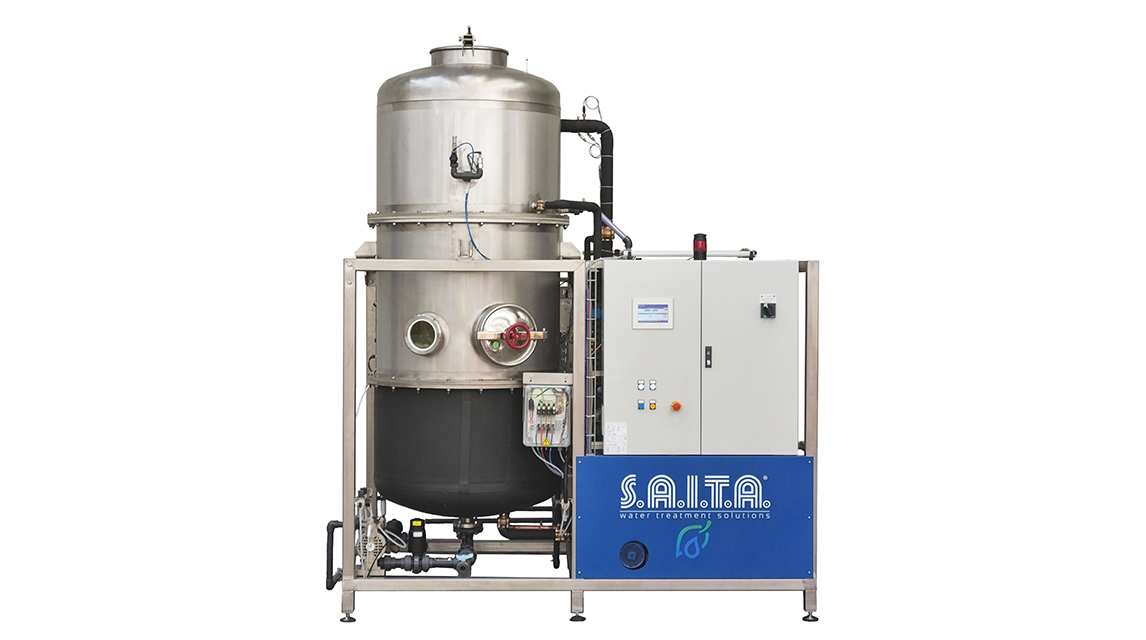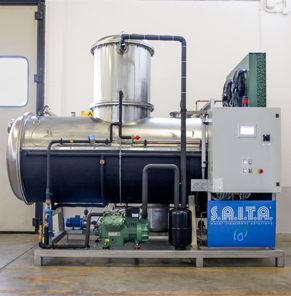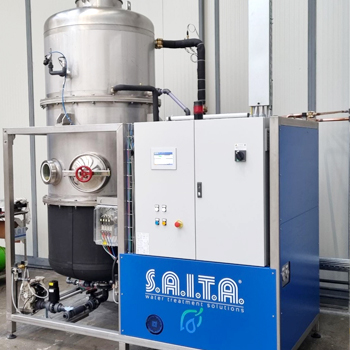Impianti trattamentoACQUE REFLUE
Home
/
vacuum-evaporators-industrial-waste-water-treatment


Vacuum evaporators allow treating industrial waste water by separating the aqueous phase from process pollutants simply bringing the starting solution to the boil and condensing the generated steam as distilled water. They are used to treat waste solutions and recover the contained water, reducing the quantity of waste to dispose of.
Distillation takes place in a boiler kept under vacuum to bring the solution to the boil point at a temperature of 35–38 °C. The distillate that is obtained has similar characteristics to demineralized water and can therefore be reused in the production process. Vacuum evaporators allow recovering as distillate about 90-95% of the treated waste water.
SAITA produces vacuum evaporators for wastewater starting from the analysis of the waste water you wish to concentrate. The standard models of evaporators are in fact customised according to the different solutions to be treated and at the operating conditions requested by the customer.
Management is simple and requires no particular intervention by dedicated staff. All SAITA systems are fully automatic for H24 operation. Times and operating modes can be selected from the touch-screen operator’s panel.
On request availability for remote control via Ethernet.
The CVD Series heat pump evaporators are fitted with an internal scraper (self-cleaning system) and heating jacket applied on the outside of the boiling chamber where Freon gas is circulating. They are applied to treat waste water solutions which contain pollutants as oils, salts, metals, colloids, dyes or process raw materials. The treatment with the CVD Series evaporators allows obtaining very high concentration ratios, so that a thick fluid or shovelable dry residue can be obtained as concentrated fraction. The range of heat pump CVD models goes from an hourly production of distilled water of 5 l/h up to a maximum of 150 l/h.

The EVFT Series single- and multi-effect vacuum evaporators use, as heating liquid, hot water or steam that supplies a heat exchanger that can vary according to the solution that has to evaporate (shell and tube, with U tubes or plates). The condensation of the steam generated in the boiling chamber is guaranteed by cold water (evaporation tower) or refrigerated. In multi-effect evaporators, the solution is heated in the first effect, steam condenses in the second where the water to be treated evaporates and so on. A degree of vacuum corresponding to the vapour pressure required for boiling at a lower temperature is applied in each effect following the first. This principle allows reducing the consumption connected with the evaporation process considerably. SAITA produces single-, double- or triple-effect modular evaporators. Double-effect evaporators (2EV) allow saving 50% of the energy demand (calories supplied by hot water or steam), while triple-effect ones (3EV) reach even 66%.
EVTC Series low energy consumption evaporators with vapour mechanical recompression
They are based on the principle of compressing the steam and turn it into water at the boiling temperature corresponding to ordinary pressure, any latent heat is transferred to the solution to be treated in appropriate heat exchangers, realizing very efficient heat recovery. Forced circulation is used via an external exchanger where the solution to concentrate circulates, while in the boiler evaporation takes place, that is the change from the liquid state to vapour. Waste water is brought to boiling point at a temperature of about 90°C. To pre-heat the solution, electrical resistors or heat recovery systems available on the production site are used. This technology allows reducing energy consumption to 40 Wh per litre of distillate produced. The application of thermocompression evaporators is recommended for the treatment of large volumes of waste water with low pollutant concentrations and especially the evaporation of reverse osmosis concentrates, emulsions, leachates, wash waters, etc.
The EV Series vacuum evaporators are characterized by the use of a heat pump as the energy source used to heat the aqueous solution and to condense the vapours. The distillation process is kept under vacuum, allowing optimal separation of the water from the pollutants contained in it and recovering over 90% of distilled water. EV evaporators consist of a boiler in stainless steel or special alloys. The heat exchange takes place using immersed coil-wound or shell and tube exchangers. The vacuum is created thanks to a closed circuit where water is circulated through a venturi ejector. The operation of heat pump vacuum evaporators requires only power and compressed air with an average consumption of about 150 Wh per litre of distilled product.
